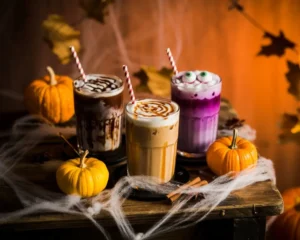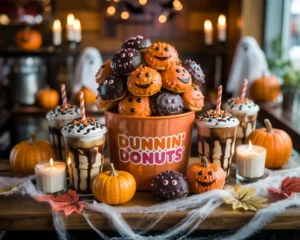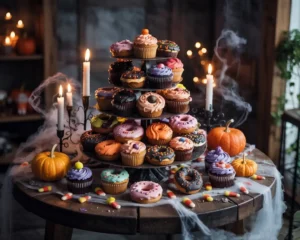INTRODUCTION
For many, Dunkin’ is the go-to place for a reliable caffeine fix. But did you know that not all Dunkin drinks deliver the same caffeine punch? Whether you want a gentle wake-up call or a serious energy boost, understanding the caffeine content of your favorite Dunkin beverages is essential.
This guide breaks down the caffeine content across Dunkin’s most popular drinks, explains how size and customization impact caffeine levels, and offers tips to help you pick the perfect cup for your energy needs — without the jitters or crashes.
Ready to sip smarter? Let’s dive into the caffeine secrets behind Dunkin’s menu.

1. Understanding Dunkin’s Caffeine Basics
To choose your perfect cup, first get clear on how caffeine works and how Dunkin serves it up.
1.1 What is Caffeine and How Does it Affect You?
Caffeine is a natural stimulant found in coffee, tea, and some sodas. It boosts alertness by blocking adenosine, a brain chemical that promotes tiredness.
Effects of caffeine:
- Increased focus and energy
- Faster reaction time
- Possible jitters or anxiety if consumed too much
Everyone’s caffeine tolerance differs, so knowing your limits helps you avoid unwanted side effects.
1.2 How Dunkin Brews Influence Caffeine Levels
Dunkin offers brewed coffee, espresso shots, cold brew, and specialty drinks — all with different caffeine concentrations due to preparation methods and coffee bean blends.
- Brewed Coffee: Made by dripping hot water over ground coffee beans; typically has more caffeine per ounce than espresso.
- Espresso: Concentrated coffee brewed by forcing hot water through finely ground beans; has less caffeine per ounce but usually served in smaller shots.
- Cold Brew: Steeped in cold water for hours, resulting in smooth, highly concentrated coffee with higher caffeine than regular iced coffee.

2. Caffeine Content in Popular Dunkin Drinks
Here’s a detailed look at caffeine amounts you can expect in your favorite Dunkin beverages (medium size unless otherwise noted).
2.1 Dunkin Brewed Coffee
- Regular Brewed Coffee (medium): ~210 mg caffeine
- Dark Roast Brewed Coffee (medium): ~180 mg caffeine
Brewed coffee offers a solid caffeine hit, perfect for those who like to sip throughout the day.
2.2 Espresso-Based Drinks
- Single Espresso Shot: ~75 mg caffeine
- Latte (1 shot): ~75 mg caffeine
- Cappuccino (1 shot): ~75 mg caffeine
- Americano (1 shot): ~75 mg caffeine
Want more caffeine? Simply add extra espresso shots at about 75 mg each.
2.3 Cold Brew Coffee
- Classic Cold Brew (medium): ~200 mg caffeine
- Nitro Cold Brew (medium): ~280 mg caffeine
Cold brew is a caffeine powerhouse, with nitro cold brew delivering the highest levels thanks to nitrogen infusion that enhances texture and flavor.
2.4 Dunkin Refreshers
- Medium Refresher (e.g., Strawberry Dragonfruit): ~80 mg caffeine
Refreshers contain green tea extract or coffee concentrate, offering a lighter caffeine option with a fruity twist.
2.5 Decaf and Non-Coffee Options
- Decaf Brewed Coffee: 2–5 mg caffeine
- Tea (black or green, medium): 30–50 mg caffeine
For caffeine-sensitive customers, decaf and tea are safer bets with minimal stimulation.
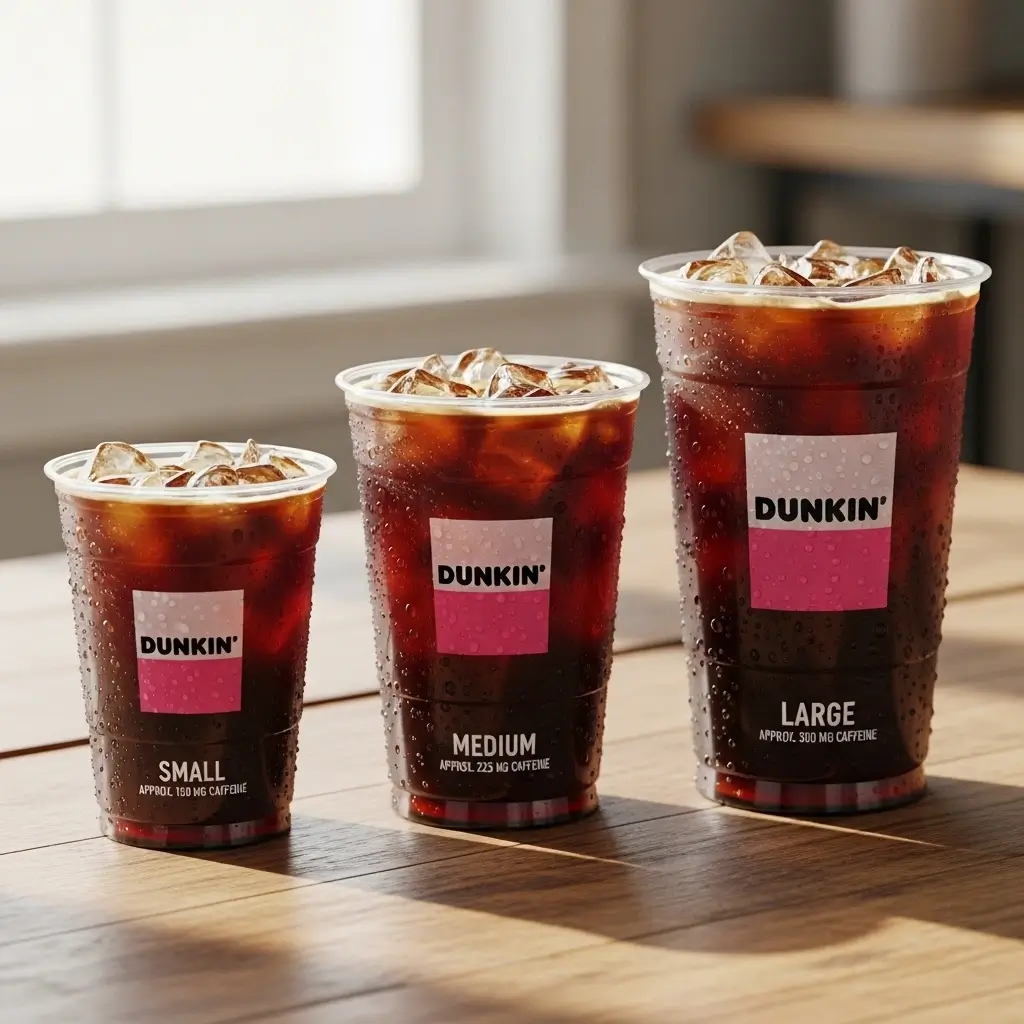
3. How Drink Size Impacts Your Caffeine Intake
Knowing caffeine content per size helps you control your intake precisely.
3.1 Dunkin Size Guide and Caffeine Multipliers
- Small (10 oz): Base caffeine minus about 20% from medium size.
- Medium (14 oz): Standard caffeine level for menu items listed here.
- Large (20 oz): About 30–40% more caffeine than medium.
- Extra Large (24 oz, where available): Up to 50% more caffeine.
3.2 Examples: Caffeine by Size for Dunkin Brewed Coffee
- Small Brewed Coffee: ~165 mg caffeine
- Medium Brewed Coffee: ~210 mg caffeine
- Large Brewed Coffee: ~280 mg caffeine
- Extra Large Brewed Coffee: ~315 mg caffeine
3.3 Size Impact on Espresso Drinks
Espresso-based drinks typically use a set number of shots regardless of size, but larger sizes may include more shots on the menu or upon request.
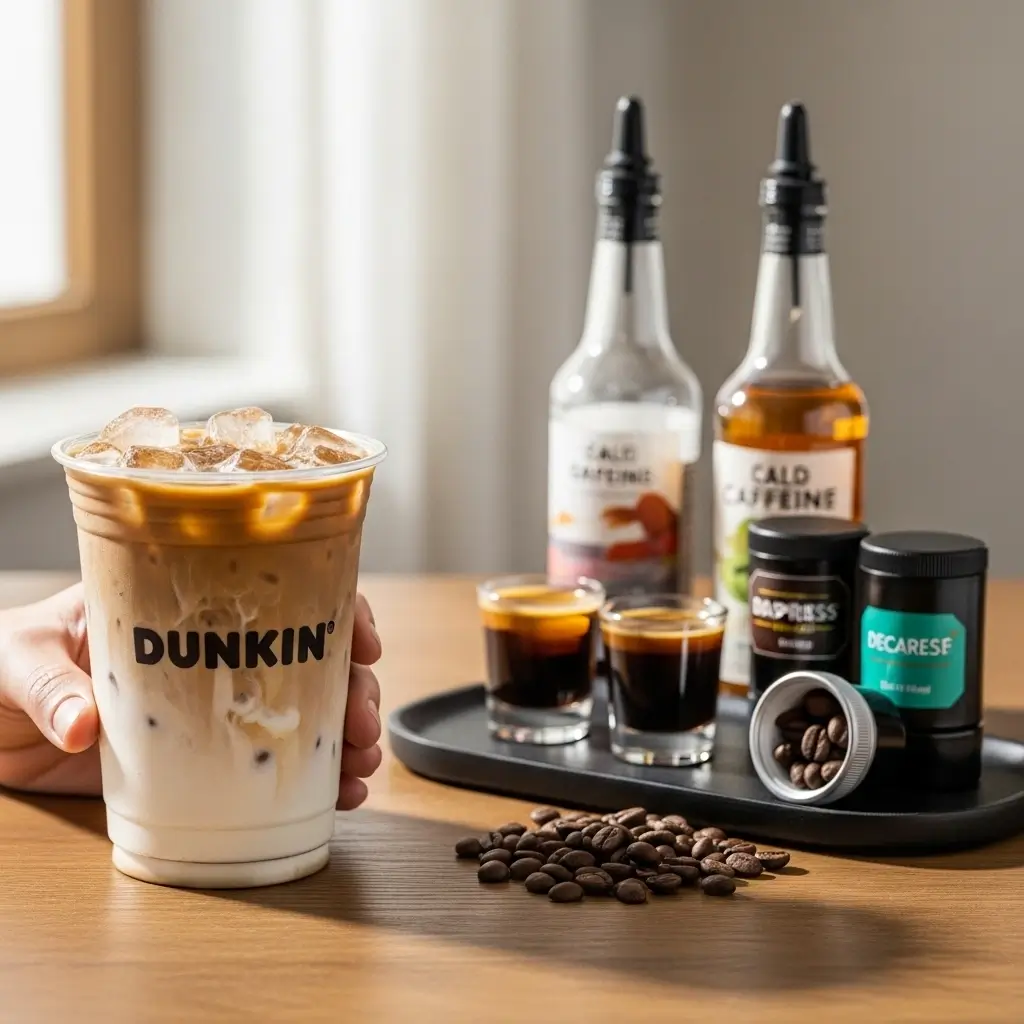
4. Tips to Customize Your Caffeine Level at Dunkin
Control your caffeine experience by customizing your order wisely.
4.1 Adding or Reducing Espresso Shots
- Adding espresso shots increases caffeine by ~75 mg each.
- Request fewer shots to lower caffeine but keep flavor.
4.2 Choosing Between Brewed and Cold Brew
Cold brew has higher caffeine and smoother taste — great for energy, but stick to brewed coffee if you want a milder boost.
4.3 Opting for Decaf or Half-Caf Blends
Decaf options provide minimal caffeine for those avoiding stimulants. Some Dunkin locations offer half-caf (half regular, half decaf) to balance flavor and caffeine.
4.4 Milk and Sweetener Impact
While milk and sweeteners don’t affect caffeine, choosing non-dairy milks like oat or almond can impact calories and flavor profile.
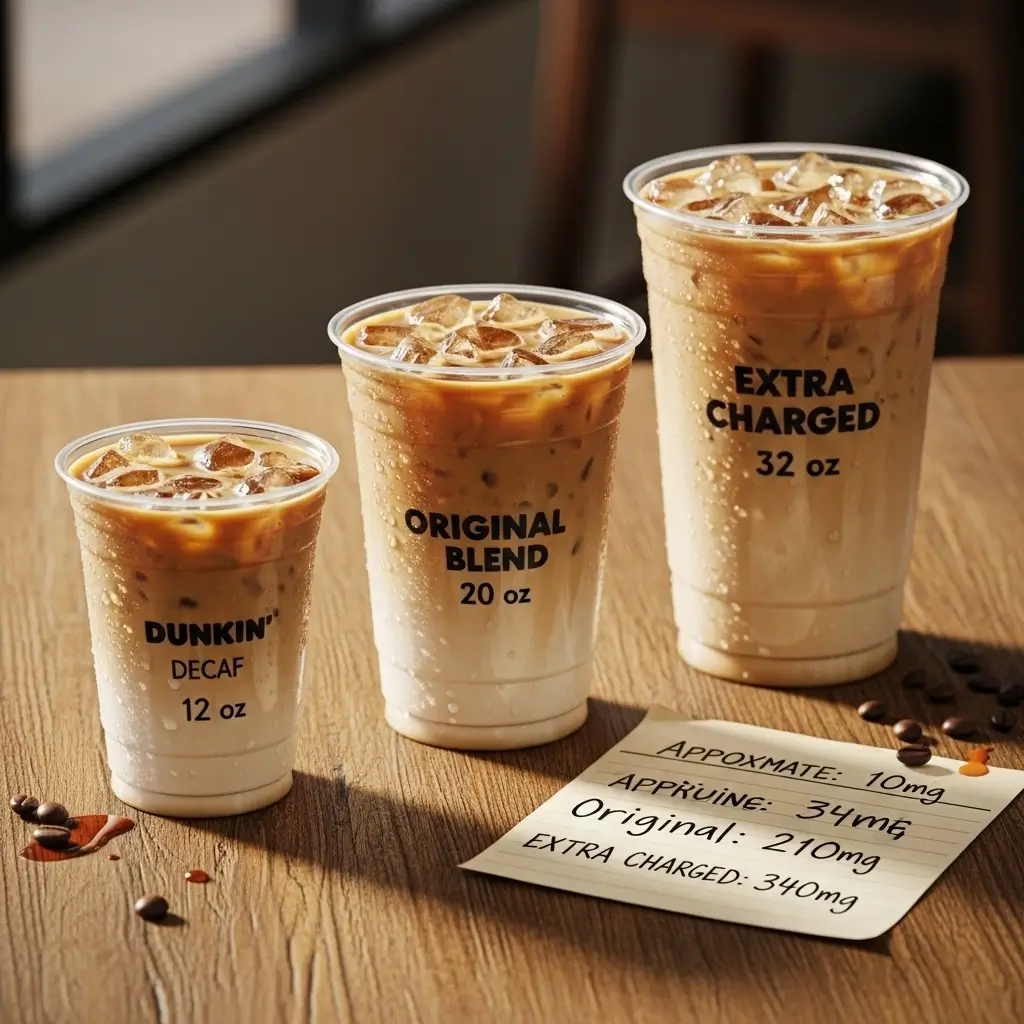
5. How to Choose Your Perfect Dunkin Cup Based on Caffeine Needs
Pick your ideal drink by matching caffeine content to your lifestyle and tolerance.
5.1 For a Morning Energy Boost
- Large Brewed Coffee (~280 mg caffeine)
- Medium Nitro Cold Brew (~280 mg caffeine)
- Espresso with extra shots
5.2 For a Moderate Pick-Me-Up
- Medium Brewed Coffee (~210 mg caffeine)
- Medium Cold Brew (~200 mg caffeine)
- Dunkin Refresher (~80 mg caffeine)
5.3 For a Light Caffeine Lift
- Small Brewed Coffee (~165 mg caffeine)
- Medium Tea (~40 mg caffeine)
- Decaf Latte or Brewed Coffee (2–5 mg caffeine)
5.4 For Sensitive or Caffeine-Averse Customers
- Decaf coffee or tea
- Hot chocolate or other caffeine-free drinks
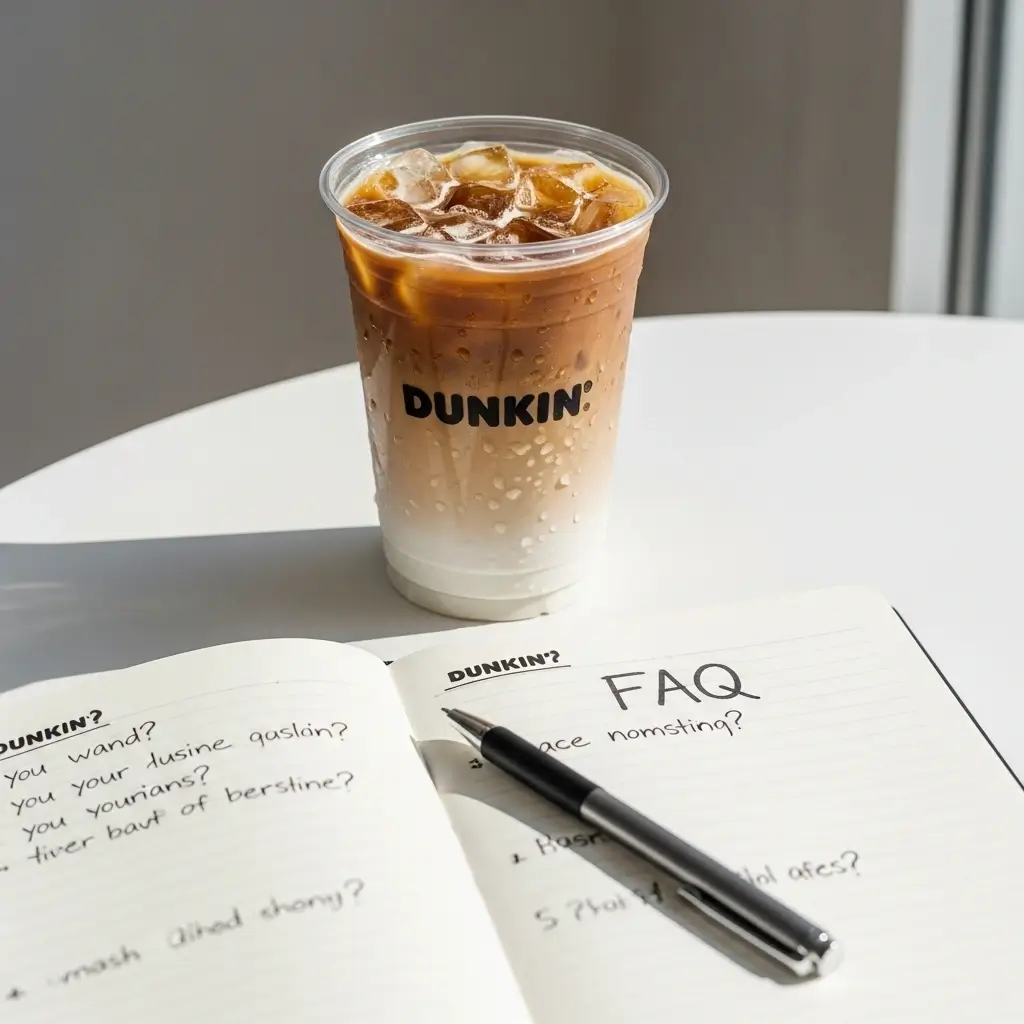
BONUS: Dunkin Caffeine Myths & FAQs
Q: Does iced coffee have more caffeine than hot coffee?
A: Not necessarily. Iced coffee is typically brewed hot then cooled, so caffeine content is similar. Cold brew, however, is steeped cold and often has higher caffeine.
Q: How long does caffeine stay in your system?
A: Typically 4–6 hours, but it varies based on metabolism and tolerance.
Q: Can you mix cold brew and espresso?
A: Yes! Some customers order an “espresso cold brew” for an extra kick.
Q: Does adding milk affect caffeine?
A: Milk changes flavor and texture but not caffeine content.
CONCLUSION
Understanding the caffeine content in Dunkin drinks empowers you to tailor your caffeine experience perfectly. Whether you’re after a strong wake-up call, a light afternoon pick-me-up, or a caffeine-free treat, Dunkin’s menu has you covered.
Next time you order, use this guide to choose your ideal drink size, type, and customizations — making every cup your perfect cup.
👉 Looking to up your coffee game? Check out “How to Make Cold Brew Coffee at Home (Easy Guide)”

